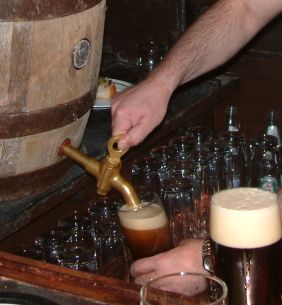
Beer is an alcoholic beverage produced by the brewing and fermentation of starches from cereal grain—most commonly malted barley, although wheat, maize (corn), rice, and oats are also used. The grain is mashed to convert starch in the grain to sugars, which dissolve in water to form wort. Fermentation of the wort by yeast produces ethanol and carbonation in the beer. Beer is one of the oldest alcoholic drinks in the world, the most widely consumed, and the third most popular drink after water and tea. Most modern beer is brewed with hops, which add bitterness and other flavours and act as a natural preservative and stabilising agent. Other flavouring agents, such as gruit, herbs, or fruits, may be included or used instead of hops. In commercial brewing, natural carbonation is often replaced with forced carbonation.
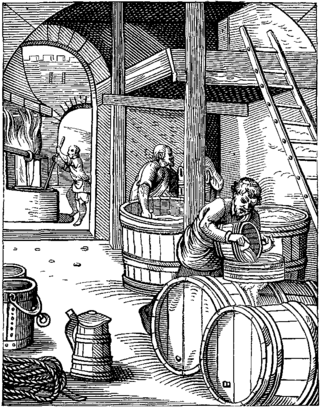
Brewing is the production of beer by steeping a starch source in water and fermenting the resulting sweet liquid with yeast. It may be done in a brewery by a commercial brewer, at home by a homebrewer, or communally. Brewing has taken place since around the 6th millennium BC, and archaeological evidence suggests that emerging civilizations, including ancient Egypt, China, and Mesopotamia, brewed beer. Since the nineteenth century the brewing industry has been part of most western economies.

Draught beer, also spelt draft, is beer served from a cask or keg rather than from a bottle or can. Draught beer served from a pressurised keg is also known as keg beer.

A beer tap is a valve, specifically a tap, for controlling the release of beer. While other kinds of tap may be called faucet, valve or spigot, the use of tap for beer is almost universal. The word was originally coined for the wooden valve in traditional barrels. Beer served from a tap is largely known as draught beer, though beer served from a cask is more commonly called cask ale, while beer from a keg may specifically be called keg beer. Beer taps can be also used to serve similar drinks like cider or long drinks.

A barrel or cask is a hollow cylindrical container with a bulging center, longer than it is wide. They are traditionally made of wooden staves and bound by wooden or metal hoops. The word vat is often used for large containers for liquids, usually alcoholic beverages; a small barrel or cask is known as a keg.

A mallet is a tool used for imparting force on another object, often made of rubber or sometimes wood, that is smaller than a maul or beetle, and usually has a relatively large head.

A drum is a cylindrical shipping container used for shipping bulk cargo. Drums can be made of steel, dense paperboard, or plastic, and are generally used for the transportation and storage of liquids and powders. Drums are often stackable, and have dimensions designed for efficient warehouse and logistics use. This type of packaging is frequently certified for transporting dangerous goods. Proper shipment requires the drum to comply with all applicable regulations.

A bunghole is a hole bored in a liquid-tight barrel to remove contents. The hole is capped with a cork or cork-like stopper called a bung. Acceptable usage includes other access points that may be capped with alternate materials providing an air- or water-tight access to other vessels. For example, a bunghole on a combustion chamber can be used to remove slag or add coal. Bungholes can also be utilized to insert and remove sensing probes or equipment like mixers to agitate the contents within a vessel.

A stopper, bung, or cork is a cylindrical or conical closure used to seal a container, such as a bottle, tube, or barrel.
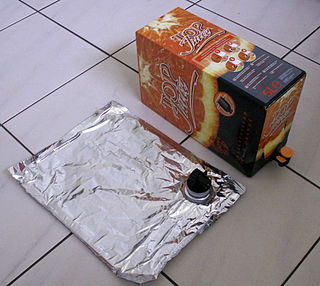
A bag-in-box or BiB is a container for the storage and transportation of liquids. It consists of a strong bladder, usually made of several layers of metallised film or other plastics, seated inside a corrugated fiberboard box.

A keg is a small cask used for storing liquids. Wooden kegs made by a cooper were used to transport nails, gunpowder, and a variety of liquids. Nowadays a keg is normally constructed of stainless steel, although aluminium can be used if it is coated with plastic on the inside. It is commonly used to store, transport, and serve beer. Other alcoholic or non-alcoholic drinks, carbonated or non-carbonated, may be housed in a keg as well. Carbonated drinks are generally kept under pressure in order to maintain carbon dioxide in solution, preventing the beverage from becoming flat.
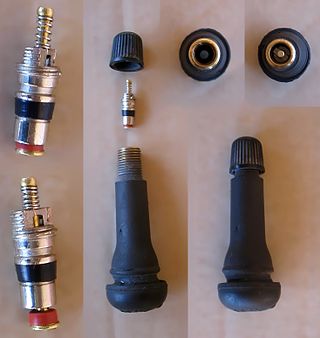
The Schrader valve is a type of pneumatic tire valve used on virtually every motor vehicle in the world today. The Schrader company, for which it was named, was founded in 1844 by August Schrader. The original Schrader valve design was invented in 1891, and patented in the United States in 1893.

Gose is a warm fermented beer that is usually brewed with at least 50% of the grain bill being malted wheat, fruit syrups- such as lemon, coriander- and salt - either added or a component of the water used. It acquires its characteristic sourness through inoculation with Lactobacillus bacteria, which is not a hop-tolerant bacteria and which provides only a light acidity. Unlike some beers, such as India pale ales, gose beers typically do not have prominent hop bitterness, flavours, or aroma and have a relatively low alcohol content of 4 to 5% alcohol by volume.

Beer has been brewed in England for thousands of years. As a beer brewing country, it is known for top fermented cask beer which finishes maturing in the cellar of the pub rather than at the brewery and is served with only natural carbonation.
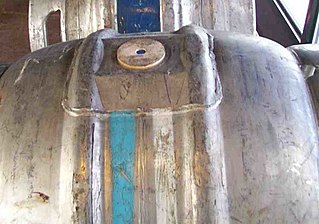
A shive is a wooden or plastic fitting used in ale casks. It is found on the curved side of the cask, arranged so that when the cask is on its side and the keystone is at the lowest part of the rim, the shive will be the highest point of the cask.

A spile is a wooden or metal peg used to control the flow of air into, and carbon dioxide out of, a cask of ale or wine. Spiles can also be used to broach liquids from a tree.
A stillage is like a pallet or skid, but with a cage or sides, or some form of support specifically tailored to the material it is intended to carry. Some are designed to be stackable.

A beer engine is a device for pumping beer from a cask, usually located in a pub's cellar.
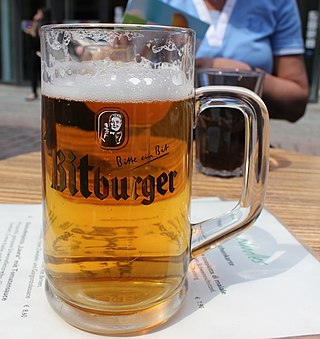
Filtered beer refers to any ale, lager, or fermented malt beverage in which the sediment left over from the brewing process has been removed. Ancient techniques included the use of straw mats, cloth, or straws, and frequently left some sediment in the drink. Modern filtration, introduced at the end of the 19th century, uses a mechanical process that can remove all sediment, including yeast, from the beer. Such beer is known as bright beer and requires force carbonation before bottling or serving from a keg. In the United Kingdom, a beer which has been filtered in the brewery is known as "brewery-conditioned", as opposed to unfiltered cask ales.
Capacities of brewery casks were formerly measured and standardised according to a specific system of English units. The system was originally based on the ale gallon of 282 cubic inches. In United Kingdom and its colonies, with the adoption of the imperial system in 1824, the units were redefined in terms of the slightly smaller imperial gallon. The older units continued in use in the United States.



















